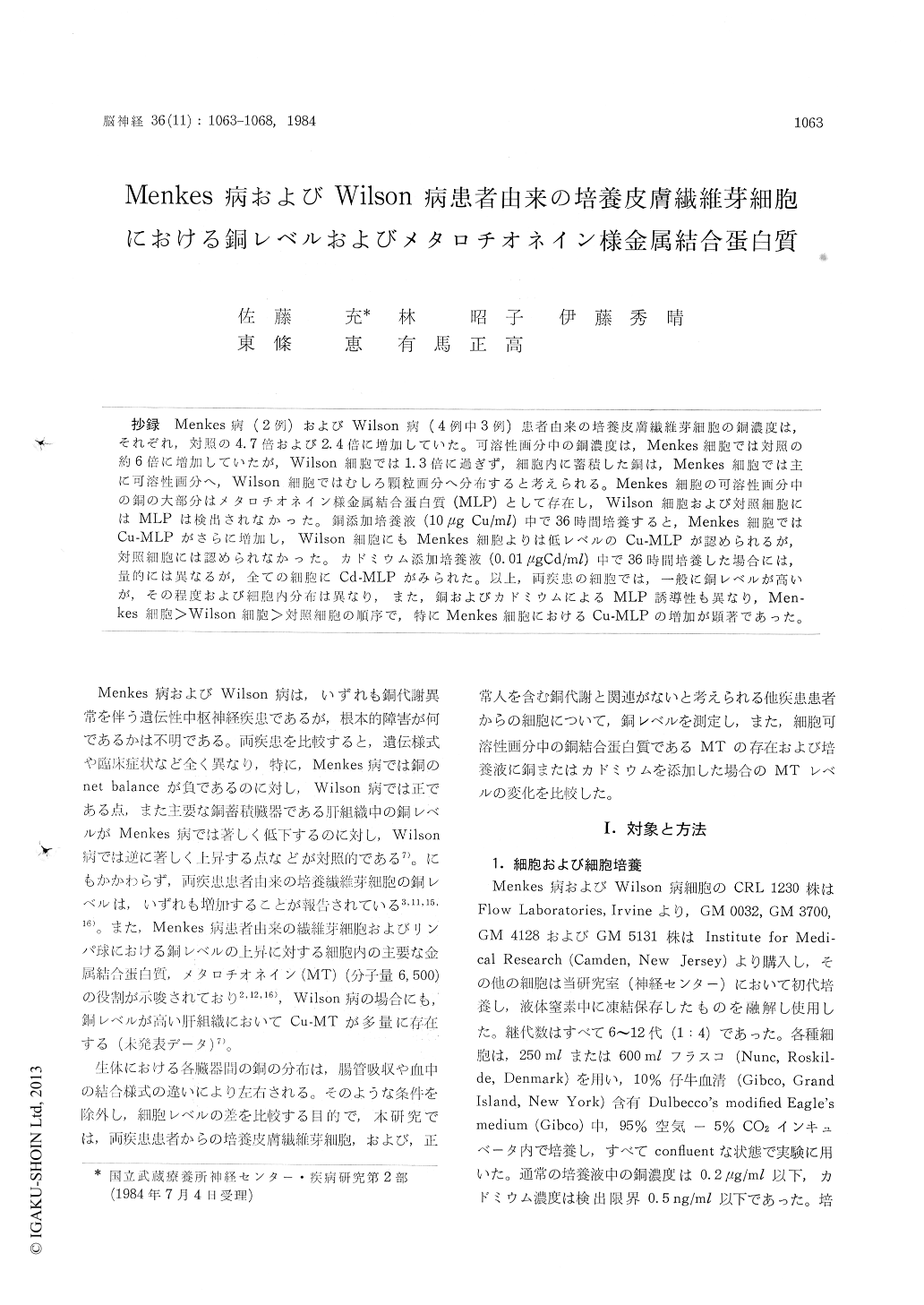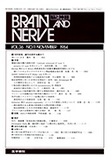Japanese
English
- 有料閲覧
- Abstract 文献概要
- 1ページ目 Look Inside
抄録 Menkes病(2例)およびWilson病(4例中3例)患者由来の培養皮膚繊維芽細胞の銅濃度は,それぞれ,対照の4.7倍および2.4倍に増加していた。可溶性画分中の銅濃度は,Menkes細胞では対照の約6倍に増加していたが,Wilson細胞では1.3倍に過ぎず,細胞内に蓄積した銅は,Menkes細胞では主に可溶性画分へ,Wilson細胞ではむしろ顆粒画分へ分布すると考えられる。Menkes細胞の可溶性画分中の銅の大部分はメタロチオネイン様金属蛋白質(MLP)として存在し,Wilson細胞および対照細胞にはMLPは検出されなかった。銅添加培養液(10μg Cu/ml)中で36時間培養すると,Menkes細胞ではCu-MLPがさらに増加し,Wilson細胞にもMenkes細胞よりは低レベルのCu-MLP力認められるが,対照細胞には認められなかった。カドミウム添加培養液(0.01μgCd/ml)中で36時間培養した場合には,量的には異なるが,全ての細胞にCd-MLPがみられた。以上,両疾患の細胞では,一般に銅レベルが高いが,その程度および細胞内分布は異なり,また,銅およびカドミウムによるMLP誘導性も異なり,Men—kes細胞>Wilson細胞>の順序で,特にMenkes細胞におけるCu-MLPの増加が顕著であった。
Copper concentration, intracellular copper dist-ribution, and inducibility of metallothionein-like metal-binding protein (MLP) by copper or cadmium addition to culture medium were compared among three types of skin fibroblasts derived from pa-tients with Menkes' disease and Wilson's disease, both exhibiting genetic defects of copper meta-bolism, and from normal subjects (control).
Skin fibroblasts were cultivated in Dulbccco's modified Eagle's medium supplemented with 10% fetal calf serum and antibiotics in 5% CO2 at 37 ℃. Cells were harvested with rubber-policeman, washed twice with phosphate-buffered saline, pH 7.2, suspended in deionized water, and homoge-nized. The homogenate from each cell type was used to determine the concentration of copper by atomic absorption spectrophotometry employing graphite-rod atomizer after lyophilization, ashing in HNO3, and coprecipitation with zirconium. Intracellular copper concentration was elevated in Menkes' cells (420 ng Cu/mg of protein) and Wil-son's cells (217 ng Cu/mg of protein) than in cont-rol cells (90.0 ng Cu/mg of protein), although one of four Wilson's strains showed normal copper level (70.5 ng Cu/mg of protein). Cytosol copperconcentration was 5.8-fold higher in Menkes' cells but only 1.3-fold in Wilson's cells than in control cells, and cytosol copper accounted for only 35% of total intracellular copper in Wilson's cells as compared with 68% and 52% in Menkes' and control cells, respectively. These suggest that accumulated copper in each cell type is differently distributed within cells ; in Menkes' cells exclusi-vely into cytosol, but in Wilson's cells into par-ticulates rather than cytosol.
Elution profiles from Sephadex G-75 columns indicated that most of copper had bound to MLP in Menkes' cells, though no Cu-MLP was detec-table in Wilson's or control cells under these experimental conditions. After cultivation in Cu-supplemented medium (10 μg/ml) for 36 h, copper bound to MLP was increased in Menkes' cells and observed at a lower level in Wilson's cells but not in control cells. In contrast with Cu-addition, Cd-MLP was seen in all three types of cells 36 h after cultivation in Cd-supplemented medium (0.01 μg/ml).
In summary, both Menkes' and Wilson's cells had contained more copper than control cells, except for one of four Wilson's strains. However, there were differences between both types of cells with respect to the extent of Cu-accumulation and distribution. In addition, inducibility of MLP by Cu- or Cd-addition, measured as the content of metals bound to MLP, appeared to be different among three types of cells ; Menkes' cells showed the highest, Wilson's cells followed it, and control cells showed the lowest inducibility, and the in-crease in Cu-MLP by copper was notable in Men-kes' cells. Probably, primary, inherited metabolic defects of these disorders had involved the varied copper distribution in their cultured cells.

Copyright © 1984, Igaku-Shoin Ltd. All rights reserved.


